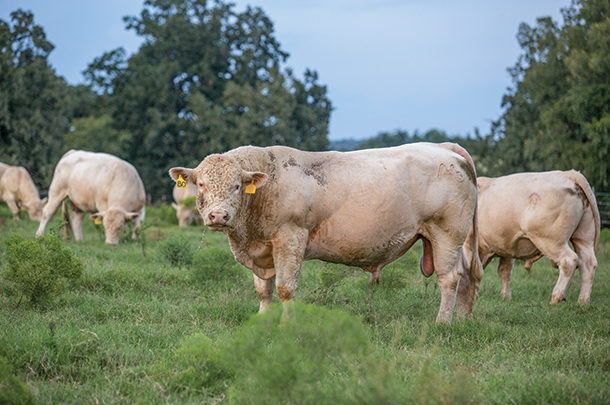In larger commercial cow-calf operations, multiple-sire breeding herds are typically used. These herds are easier to manage, with less reproductive failure risk, but more difficult to evaluate genetic improvement in your calf crop.
Seedstock operations typically use single-sire breeding pastures due to the importance of knowing the parentage of each calf in the calf crop for registering within a breed association. Single-sire breeding herds can be a great tool for evaluation of genetic improvement in your calf crop but are more difficult to manage with more risk associated due to potential reproductive failure from the bull.
I write about this topic because while I previously managed a 350-head commercial cow-calf herd in my research program at the Louisiana State University Hill Farm Research Station, we used both breeding systems that resulted in several discussions about the pros and cons of both systems. This made for some great discussion as to which was more valuable to a program.
Herd sires contribute half of the genetic potential to all of the calves they sire; therefore, bull selection can provide the most significant genetic improvement in a herd. Herd bulls can have the biggest impact – negatively or positively – on herd fertility, significantly affecting an entire calf crop. As we know, the percent calf crop weaned is the single-most important factor influencing profitability and is directly tied to the herd bull’s breeding capability. Thus, bulls should be managed to optimize breeding performance.
Careful evaluation of herd goals and consideration of the pros and cons of each system should determine if using single- or multiple-sire breeding herds is the appropriate breeding system for your operation. Here are some pros and cons to consider.
Single-sire breeding herds
Pros:
- Easier and accurate identification of a calf sire
- More likely to get more calves out of a single sire
- Eliminate potential injury to bulls from fighting during the breeding season
- Allows for easier management of a crossbreeding system during the breeding season
- Ability to use younger bulls without the risk of injury from older bulls
Cons:
- Requires more sorting of the cow herd into smaller breeding herds
- Requires more breeding pastures to be managed for forage, water and fencing
- Increased risk of reproductive failure from the bull due to potential health, injury or poor semen quality during the breeding season
- Potentially requires a backup bull or bulls in case a bull needs to be pulled from a breeding herd
- Limited use of estrous synchronization with natural service due to adjusting the bull-to-cow ratio
Multiple-sire breeding herds
Pros:
- Reduces sorting of the cow herd into multiple breeding herds
- Reduces the number of breeding pastures to manage
- Easier to manage for forage, water and fencing
- Depending on the breed makeup of the cow herd, bulls of different breed makeup can help to identify a calf’s breed of sire (i.e., black-hided cow herd with Angus and Charolais bulls)
- Can utilize technologies such as estrous synchronization with natural service to increase the number of cows conceiving early in the breeding season
- The risk of reproductive failure is reduced due to other bulls used in the breeding herd
- Fewer backup bulls are required
Cons:
- More difficult and more expensive process of identifying calf sire
- Risk of getting fewer calves out of a particular sire due to social dominance
- Increased risk of injury from other bulls due to fighting
- Challenge of bringing in and using younger, virgin bulls
Operation size will drive the decision for commercial cow-calf producers most of the time. A smaller commercial cow-calf producer with only 30 cows or fewer may only own one herd sire. However, a larger commercial cow-calf producer with limited number of pastures with good fencing, forage and access to water at that time of year may need to manage for multiple-sire breeding herds.
In a single-sire breeding system, the biggest benefit I see is knowing the sires of those calves so you can determine if genetic improvement is being made in your calf crop. With that said, because there is only one bull with that breeding herd, routine and close monitoring of that bull needs to be conducted to ensure he has not been injured or become sick during the breeding season and is aggressively getting those cows bred.
In a multiple-sire breeding system, the biggest benefit I see is the ease of managing fewer breeding herds with the ability to use estrous synchronization to increase the number of cows conceiving early on in the breeding season. The biggest disadvantage for me is not knowing the sire of those calves without having to collect DNA after birth for parentage.
When considering what breeding system you want to use, determine what the limiting factors are to using each system and what factors are most important to you in accomplishing your goals to help make that decision. ![]()
PHOTO: Herd sires contribute half of the genetic potential to all calves they sire; therefore, bull selection can provide the most significant genetic improvement in a herd. Photo courtesy of Noble Research Institute.

-
Ryon Walker
- Livestock Consultant
- Noble Research Institute
- Email Ryon Walker








